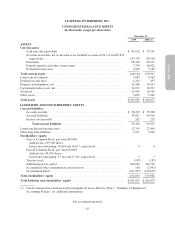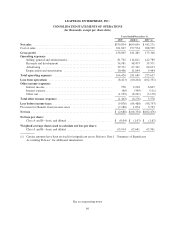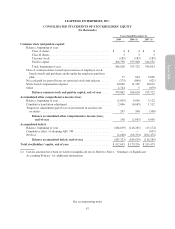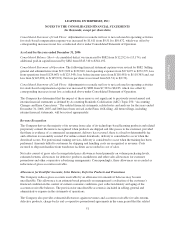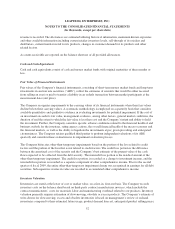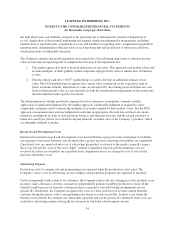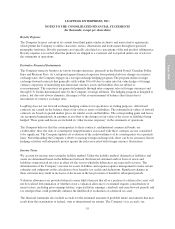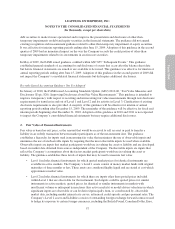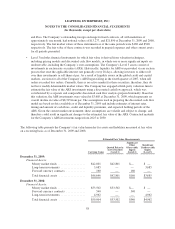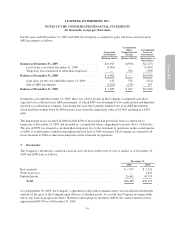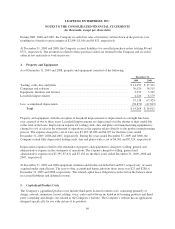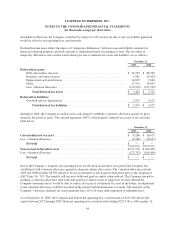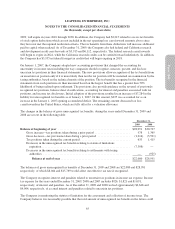LeapFrog 2009 Annual Report Download - page 65
Download and view the complete annual report
Please find page 65 of the 2009 LeapFrog annual report below. You can navigate through the pages in the report by either clicking on the pages listed below, or by using the keyword search tool below to find specific information within the annual report.
LEAPFROG ENTERPRISES, INC.
NOTES TO THE CONSOLIDATED FINANCIAL STATEMENTS
(In thousands, except per share data)
Royalty Expense
The Company licenses certain of its content from third parties under exclusive and nonexclusive agreements,
which permit the Company to utilize characters, stories, illustrations and trade names throughout specified
geographic territories. Royalty payments are typically calculated as a percentage of the unit product selling price.
Royalty expense is recorded when the products are shipped to a customer and is reported under cost of sales in
the statements of operations.
Derivative Financial Instruments
The Company transacts business in various foreign currencies, primarily in the British Pound, Canadian Dollar,
Euro and Mexican Peso. As a safeguard against financial exposure from potential adverse changes in currency
exchange rates, the Company engages in a foreign exchange hedging program. The program utilizes foreign
exchange forward contracts that generally settle within 30 to 60 days to enter into fair value hedges of foreign
currency exposures of underlying non-functional currency assets and liabilities that are subject to
re-measurement. The exposures are generated primarily through inter-company sales in foreign currencies and
through U.S. Dollar-denominated sales by the Company’s foreign affiliates. The hedging program is designed to
reduce, but does not always eliminate, the impact of the re-measurement of balance sheet items due to
movements of currency exchange rates.
LeapFrog does not use forward exchange hedging contracts for speculative or trading purposes. All forward
contracts are carried on the balance sheet at fair value as assets or liabilities. The estimated fair values of forward
contracts are based on quoted market prices for similar assets and liabilities. The corresponding gains and losses
are recognized immediately in earnings as an offset to the changes in fair value of the assets or liabilities being
hedged. These gains and losses are included in “other income (expense)” in the statements of operations.
The Company believes that the counterparties to these contracts, multinational commercial banks, are
creditworthy; thus, the risks of counterparty nonperformance associated with these contracts are not considered
to be significant. The Company updates its evaluation of the creditworthiness of its counterparties on a quarterly
basis. Notwithstanding the Company’s efforts to manage foreign exchange risk, there can be no assurance that its
hedging activities will adequately protect against the risks associated with foreign currency fluctuations.
Income Taxes
We account for income taxes using the liability method. Under the liability method, deferred tax liabilities and
assets are determined based on the difference between the financial statement and tax basis of assets and
liabilities using enacted tax rates in effect for the year in which the differences are expected to reverse. The
determination of the Company’s income tax assets, liabilities and expense requires management to make certain
estimates and judgments in the calculation of tax benefits, tax credits and deductions. Significant changes in
these estimates may result in increases or decreases in the tax provision or benefit in subsequent periods.
Valuation allowances are provided when it is more likely than not that all or a portion of a deferred tax asset will
not be realized. Determination of whether or not a valuation allowance is warranted requires consideration of
many factors, including prior earnings history, expected future earnings, carryback and carryforward periods, and
tax strategies that could potentially enhance the likelihood of realization of a deferred tax asset.
The financial statements also include accruals for the estimated amounts of probable future assessments that may
result from the examination of federal, state or international tax returns. The Company’s tax accruals, tax
55


